Study on Distress Characteristics of Asphalt Pavement Under Heavy-Duty Traffic Based on Lightweight Road Inspection Equipment
Abstract
1. Introduction
2. Lightweight Inspection Equipment and Data Collection
2.1. Lightweight Inspection Equipment Overview
2.1.1. High-Definition Industrial Camera
2.1.2. Positioning System
2.1.3. Mobile Central Control System
2.1.4. Vehicle-Mounted Tripod
2.2. Data Collection and Processing
2.2.1. Data Collection
2.2.2. Data Processing
3. Research on the Development of EPCI Indicators Under High Traffic Volume
3.1. Basic Information of the Existing Road
3.2. Analysis of the Overall Situation of Automated Detection Data
3.3. Analysis of the Development of Pavement Distress Conditions
4. Research on Distress Distribution of Automated Detection Under Heavy-Duty Traffic
4.1. Research on Distress Distribution of Automated Detection Under Heavy-Duty Traffic
4.2. Analysis of Distress Development in the Same Lane
4.3. Analysis of Pavement Distress Maintenance Points and Measures
5. Conclusions
- (1)
- When maintenance records for the section are missing, high-frequency data collection using lightweight inspection equipment for aged asphalt pavements poses challenges for analyzing the deterioration of pavement distress or establishing decay models. However, on the other hand, for sections with an EPCI difference in more than 5 points, targeted reinforcement of maintenance efforts can help maintain a good service level of the pavement.
- (2)
- Under high traffic volumes, the distribution of distress in the slow lane shows that network cracks and block cracks are the most prevalent, while the passing lane and driving lane exhibit the highest occurrence of longitudinal and transverse cracks. In other words, the condition of the passing lane and slow lane is poorer than that of the driving lane. Therefore, the variability in maintenance efforts results in significant fluctuations in the EPCI of the passing and slow lanes, while the EPCI of the driving lane remains relatively stable.
- (3)
- By controlling the distress area in the upward direction to 400 m2 per lane per kilometer and in the downward direction to 500 m2 per lane per kilometer, the maintenance unit can maintain the EPCI at around 80 points, which is considered the most economical maintenance measure.
6. Discussion
- (1)
- For the old asphalt pavement that has been in service for many years, it is recommended that the management and maintenance unit divide the road maintenance ledger by kilometer. Through the data obtained by the lightweight detection equipment, a database or disease library is established to correct the data collected by the lightweight detection equipment, so as to study the decay model of the old asphalt pavement damage and lay the foundation for the realization of fine maintenance.
- (2)
- For newly constructed sections or sections that have undergone restorative maintenance projects, high-frequency data collection and analysis using lightweight inspection equipment should be conducted within the design lifespan, considering different regions, pavement structures, and traffic load levels. This will help establish pavement distress deterioration models to analyze the optimal maintenance timing for different sections. Additionally, by calculating the distress rate, the area requiring repair can be determined, and maintenance funding can be estimated. In addition, the regions with similar climatic environments are classified, and the road sections with the same pavement structure unify their disease decay models to quickly analyze or predict the approximate disease situation of the target paragraph at any time.
- (3)
- In order to improve the accuracy of the data, more research will be invested in the future research, and the same lane of the research section will be detected in different time and space for many times, so as to analyze the data in the entity engineering application in more detail. In addition, EPCI is a new indicator. In future research, it is necessary to establish a complete system of EPCI as an indicator to judge the quality of road conditions.
Author Contributions
Funding
Informed Consent Statement
Data Availability Statement
Acknowledgments
Conflicts of Interest
References
- Sermanet, P.; Eigen, D.; Zhang, X.; Mathieu, M.; Fergus, R.; LeCun, Y. Overfeat: Integrated recognition, localization and detection using convolutional networks. In Proceedings of the 2nd International Conference on Learning Representations, ICLR 2014, Banff, AB, Canada, 14–16 April 2014. [Google Scholar]
- Girshick, R.; Donahue, J.; Darrell, T.; Malik, J. Rich feature hierarchies for accurate object detection and semantic segmentation. In Proceedings of the 27th IEEE Conference on Computer Vision and Pattern Recognition, CVPR 2014, Columbus, OH, USA, 23–28 June 2014; IEEE Computer Society: Washington, DC, USA, 2014. [Google Scholar]
- Uijlings, J.R.R.; van de Sande, K.E.A.; Gevers, T.; Smeulders, A.W.M. Selective Search for Object Recognition. Int. J. Comput. Vis. 2013, 104, 154–171. [Google Scholar] [CrossRef]
- He, K.; Zhang, X.; Ren, S.; Sun, J. Spatial Pyramid Pooling in Deep Convolutional Networks for Visual Recognition. IEEE Trans. Pattern Anal. Mach. Intell. 2015, 37, 1904–1916. [Google Scholar] [CrossRef]
- Girshick, R. Fast R-CNN. In Proceedings of the 15th IEEE International Conference on Computer Vision, ICCV 2015, Santiago, Chile, 11–18 December 2015; Institute of Electrical and Electronics Engineers Inc.: New York, NY, USA, 2015. [Google Scholar]
- Ren, S.; He, K.; Girshick, R.; Sun, J. Faster R-CNN: Towards Real-Time Object Detection with Region Proposal Networks. IEEE Trans. Pattern Anal. Mach. Intell. 2017, 39, 1137–1149. [Google Scholar] [CrossRef] [PubMed]
- Redmon, J.; Divvala, S.; Girshick, R.; Farhadi, A. You only look once: Unified, real-time object detection. In Proceedings of the 29th IEEE Conference on Computer Vision and Pattern Recognition, CVPR 2016, Las Vegas, NV, USA, 26 June–1 July 2016; IEEE Computer Society: Washington, DC, USA, 2016. [Google Scholar]
- Liu, W.; Anguelov, D.; Erhan, D.; Szegedy, C.; Reed, S.; Fu, C.-Y.; Berg, A.C. SSD: Single shot multibox detector. In Proceedings of the 14th European Conference on Computer Vision, ECCV 2016, Amsterdam, The Netherlands, 8–16 October 2016; Springer: Berlin/Heidelberg, Germany, 2016. [Google Scholar]
- Ravi, R.; Habib, A.; Bullock, D. Pothole Mapping and Patching Quantity Estimates using LiDAR-Based Mobile Mapping Systems. Transp. Res. Rec. J. Transp. Res. Board 2020, 2674, 124–134. [Google Scholar] [CrossRef]
- Fakhri, S.A.; Satari Abrovi, M.; Zakeri, H.; Safdarinezhad, A.; Fakhri, A. Pavement crack detection through a deep-learned asymmetric encoder-decoder convolutional neural network. Int. J. Pavement Eng. 2023, 24, 2255359. [Google Scholar] [CrossRef]
- Sami, A.A.; Sakib, S.; Deb, K.; Sarker, I.H. Improved YOLOv5-Based Real-Time Road Pavement Distress Detection in Road Infrastructure Management. Algorithms 2023, 16, 452. [Google Scholar] [CrossRef]
- Hedeya, M.A.; Samir, E.; El-Sayed, E.; El-Sharkawy, A.A.; Abdel-Kader, M.F.; Moussa, A.; Abdel-Kader, R.F. A Low-Cost Multi-sensor Deep Learning System for Pavement Distress Detection and Severity Classification. In Proceedings of the 8th International Conference on Advanced Machine Learning and Technologies and Applications (AMLTA2022), Cairo, Egypt, 5–7 May 2022; pp. 21–33. [Google Scholar]
- Matarneh, S.; Elghaish, F.; Al-Ghraibah, A.; Abdellatef, E.; Edwards, D.J. An automatic image processing based on Hough transform algorithm for pavement crack detection and classification. Smart Sustain. Built Environ. 2025, 14, 1–22. [Google Scholar] [CrossRef]
- Redmon, J.; Farhadi, A. YOLO9000: Better, faster, stronger. In Proceedings of the 30th IEEE Conference on Computer Vision and Pattern Recognition, CVPR 2017, Honolulu, HI, USA, 21–26 July 2017; Institute of Electrical and Electronics Engineers Inc.: New York, NY, USA, 2017. [Google Scholar]
- Law, H.; Deng, J. CornerNet: Detecting Objects as Paired Keypoints. Int. J. Comput. Vis. 2020, 128, 642–656. [Google Scholar] [CrossRef]
- Zhang, A.A.; Shang, J.; Li, B.; Hui, B.; Gong, H.; Li, L.; Zhan, Y.; Ai, C.; Niu, H.; Chu, X.; et al. Intelligent pavement condition survey: Overview of current researches and practices. J. Road Eng. 2024, 4, 257–281. [Google Scholar] [CrossRef]
- Wang, S.; Cai, B.; Wang, W.; Li, Z.; Hu, W.; Yan, B.; Liu, X. Automated detection of pavement distress based on enhanced YOLOv8 and synthetic data with textured background modeling. Transp. Geotech. 2024, 48, 101304. [Google Scholar] [CrossRef]
- Yuan, B.; Sun, Z.; Pei, L.; Li, W.; Zhao, K. Shuffle Attention-Based Pavement-Sealed Crack Distress Detection. Sensors 2024, 24, 5757. [Google Scholar] [CrossRef] [PubMed]
- Wang, R.; Wang, C.; Chu, X. Research Progress on Pavement Distress Image Recognition. J. Jilin Univ. Technol. (Eng. Ed.) 2002, 19, 91–97. [Google Scholar]
- Li, L.; Sun, L.; Chen, C. Edge Detection Methods Suitable for Pavement Distress Image Processing. J. Tongji Univ. (Nat. Sci. Ed.) 2011, 39, 688–692. [Google Scholar]
- Shi, L.; Dang, L.; Yang, L.; Shi, S. Pavement Distress Image Recognition Method Based on Manifold Features Fusion. Comput. Appl. Softw. 2016, 33, 150–152, 196. [Google Scholar]
- Zhang, Y.; Li, Q.; Xue, F.; Yu, L. Design of a Pavement Crack Detection System Based on Jetson TX2. Highway 2023, 12, 337–344. [Google Scholar]
- Chen, H.; Wang, J. Infrared Asphalt Pavement Crack Detection Method Based on Improved YOLOv5. Telev. Technol. 2023, 47, 43–50. [Google Scholar]
- Zhou, Y.; Zhang, J.; Cao, J.; Liu, Y.; Zhang, H. Research on Error Compensation Algorithm for Pavement Pothole Detection Based on 3D Laser Technology. J. Highw. Traffic Technol. 2023, 40, 17–24. [Google Scholar]
- Wu, C.; Ti, J.; Ma, J. Digitalization of Asphalt Pavement Maintenance Information Based on Holographic 3D Detection Technology. Guangdong Highw. Traffic 2023, 49, 1–7. [Google Scholar]
- Chen, M.; Zhang, M.; Liu, Z.; Han, Y.; Gu, S. Design and Implementation of a Lightweight Portable Intelligent Pavement Distress Detection System. Eng. Qual. 2022, 40, 74–79. [Google Scholar]
- Chen, X.; Gao, H.; Yang, Z.; Kong, T.; Che, R. Research on Pavement Crack Distress Detection and Recognition Based on Improved YOLOv5s. Softw. Guide 2024, 23, 206–212. [Google Scholar]
- Wang, Y.; Zhou, C.; Wang, Y.; Li, W. Digital Research on Pavement Distress Based on Improved YOLOv8 Algorithm. Highway 2024, 69, 350–356. [Google Scholar]
- Zhang, H.; Dong, Y.; Hou, Y.; Cheng, X.; Xie, P.; Di, K. Research on Asphalt Pavement Surface Distress Detection Technology Coupling Deep Learning and Object Detection Algorithms. Infrastructures 2025, 10, 72. [Google Scholar] [CrossRef]

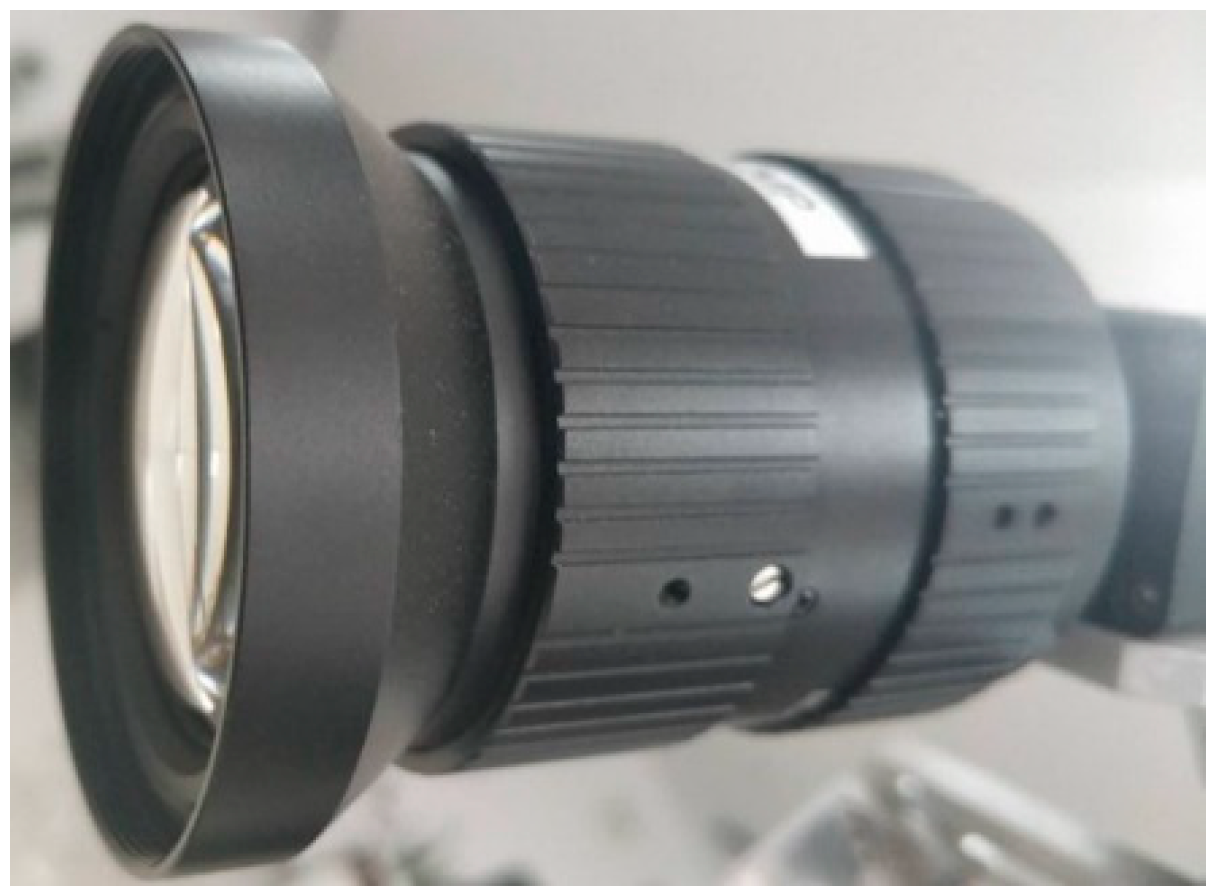
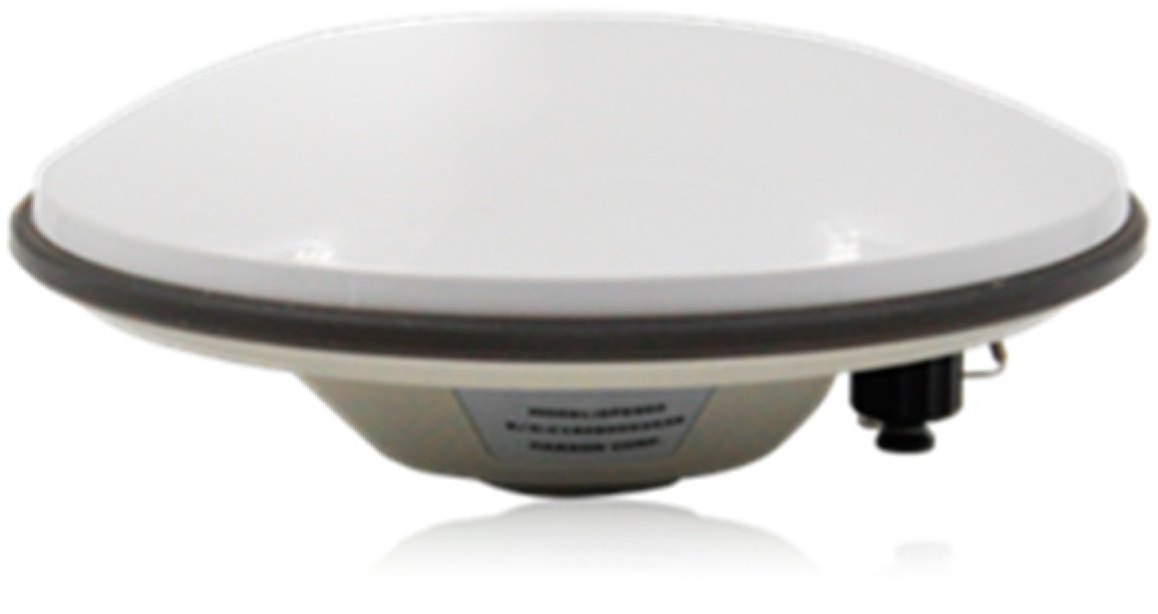

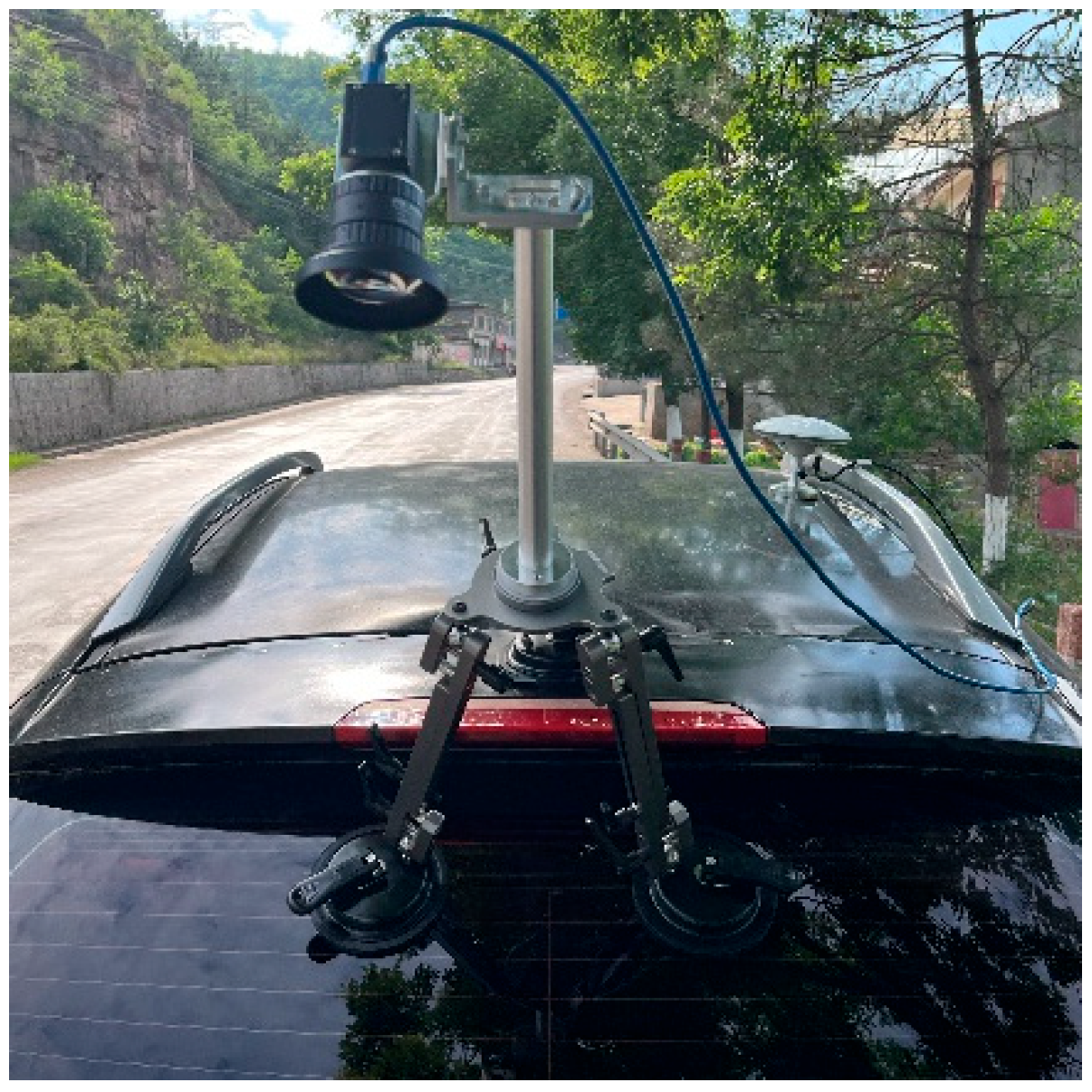





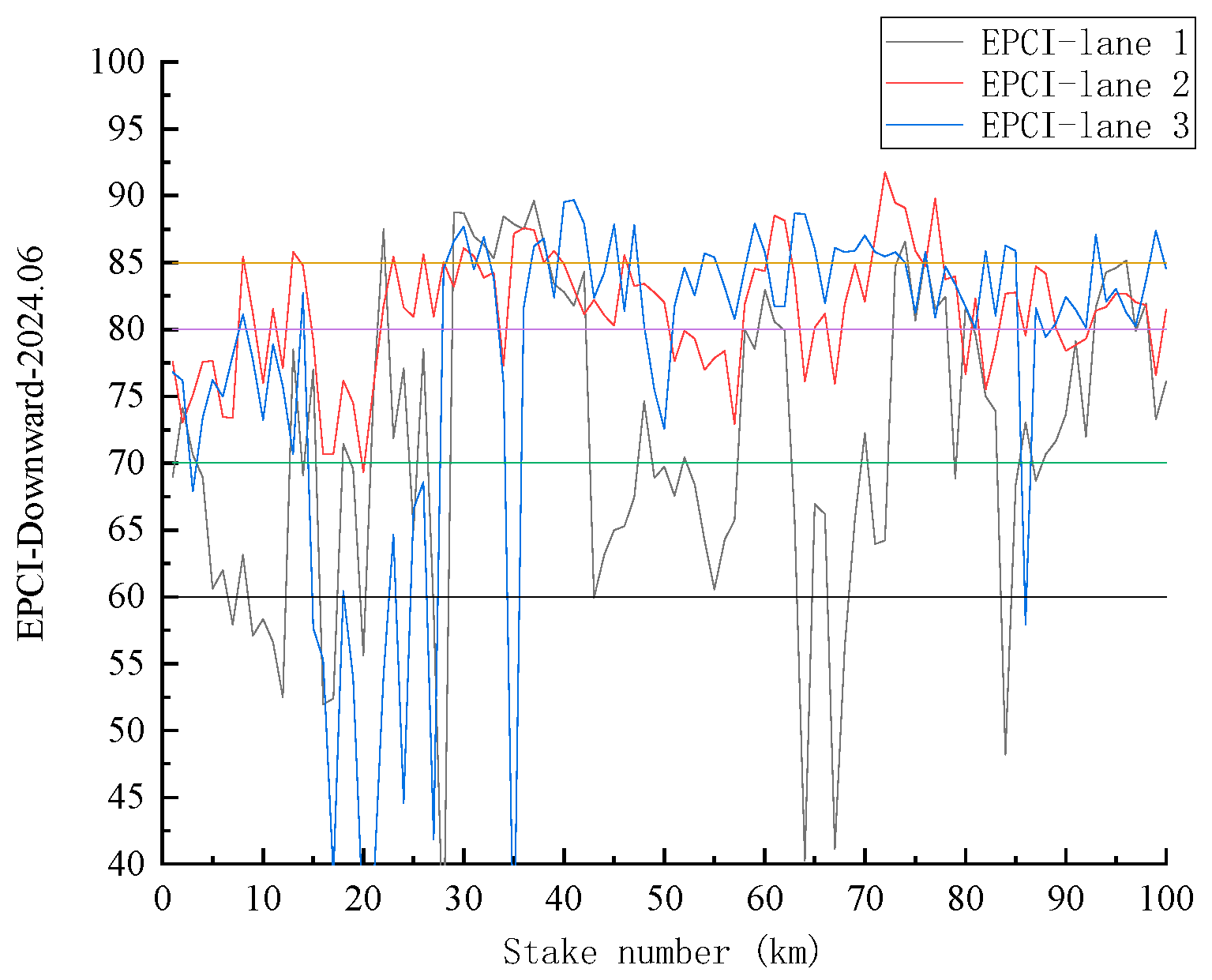



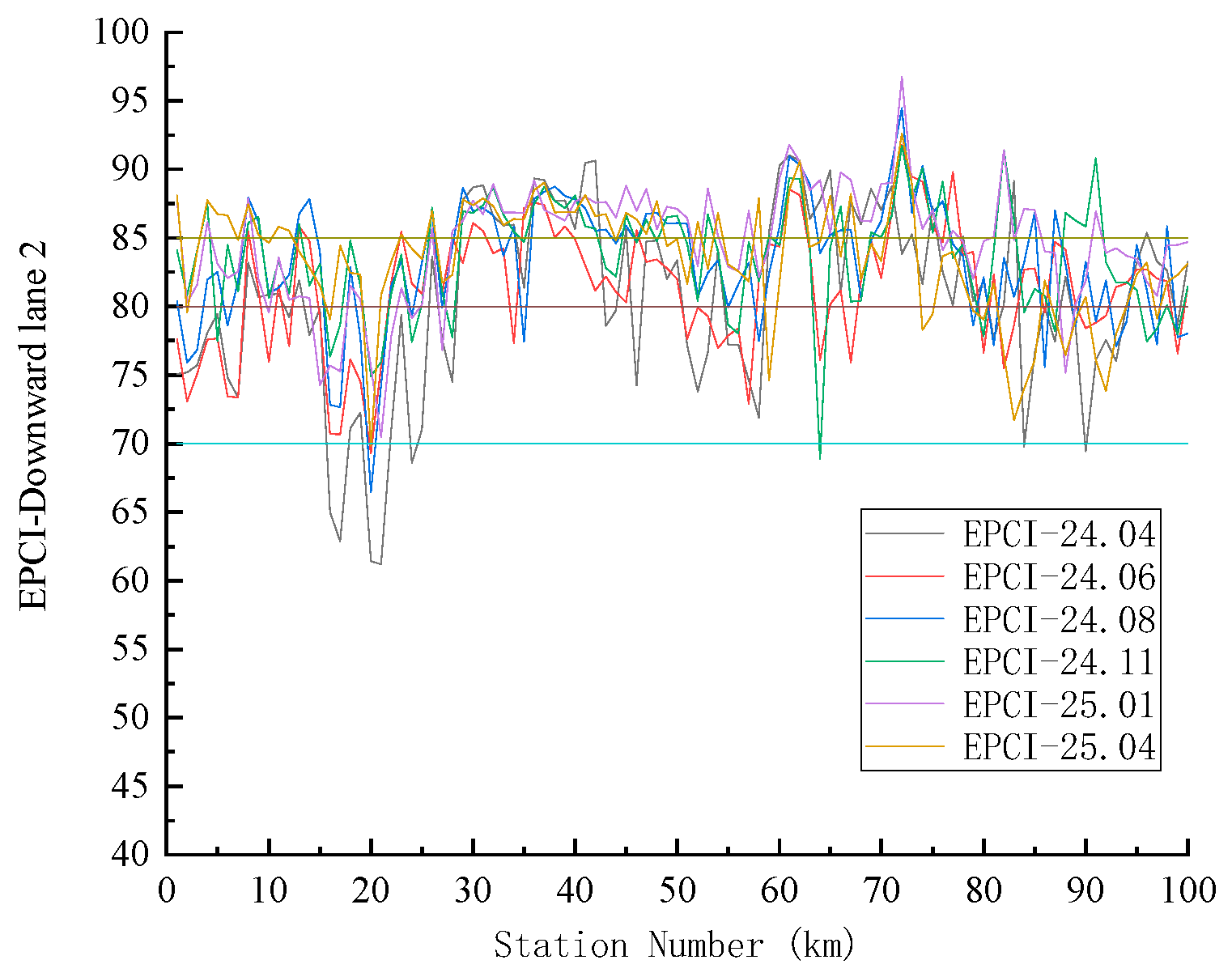
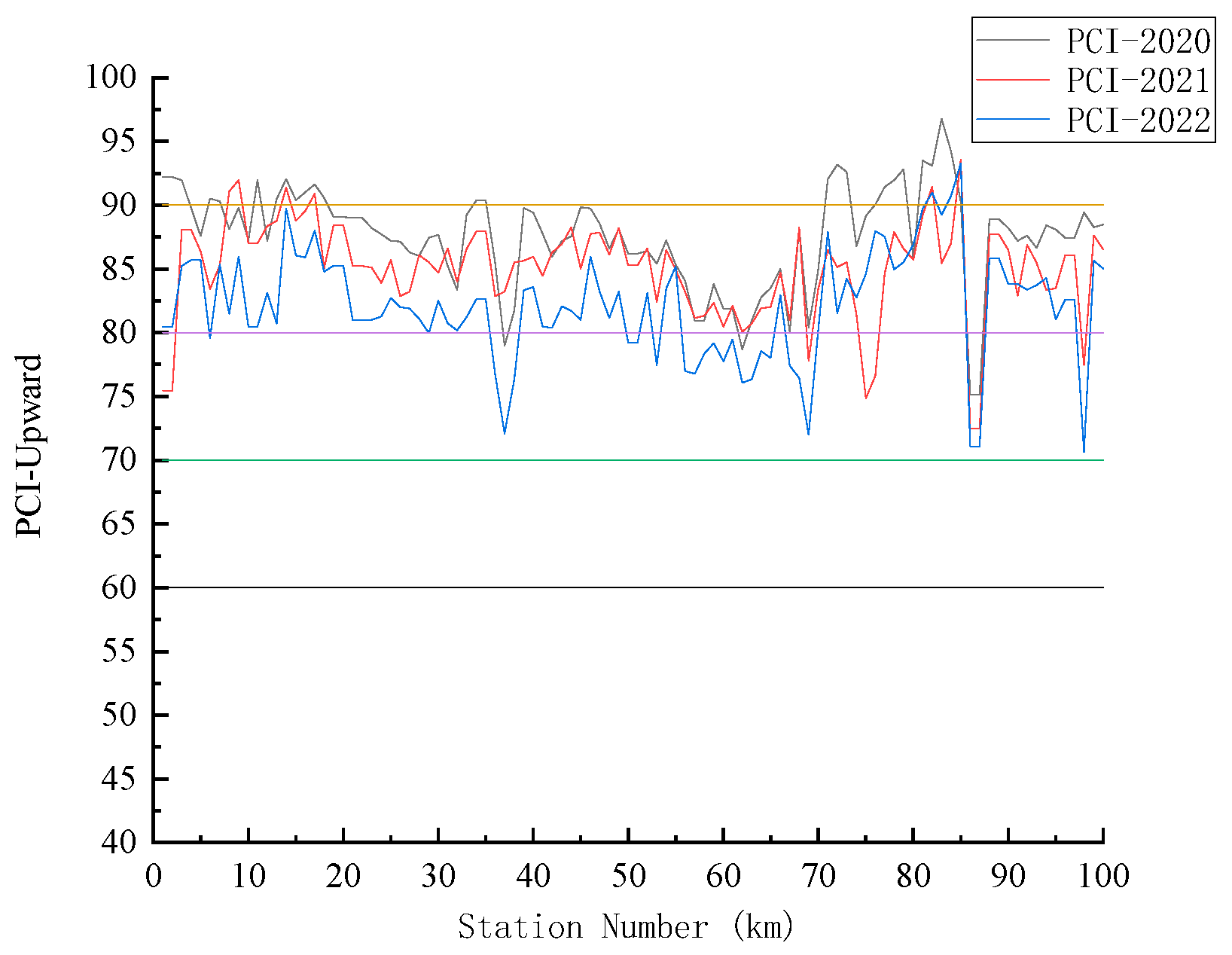

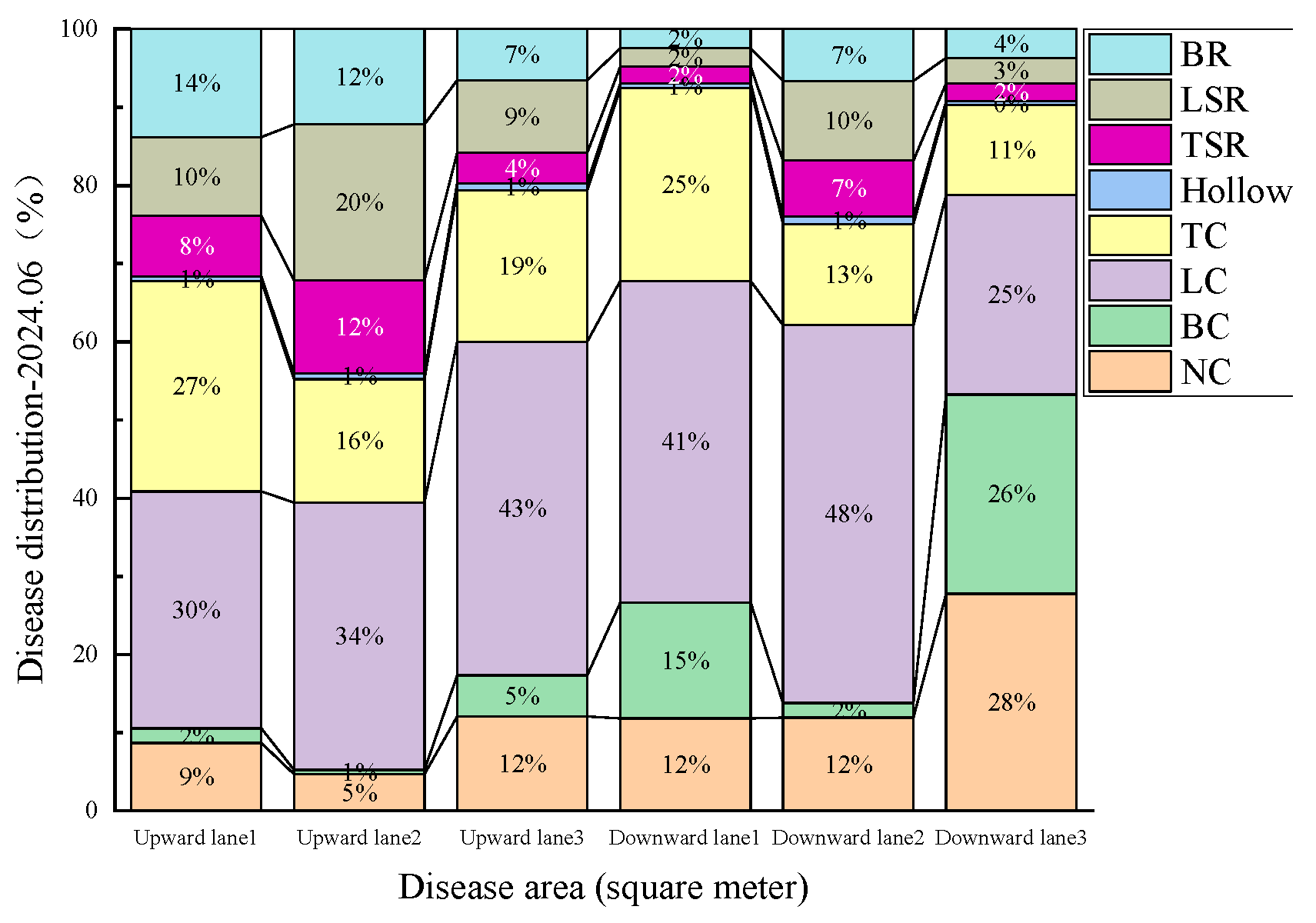



| Year | Total Daily Traffic Volume of Motor Vehicles (Vehicles/Day) | Car (Vehicle/Day) | Accumulated Traffic Volume of Large Buses and Trucks (Vehicles) | ||||||
|---|---|---|---|---|---|---|---|---|---|
| Total Equivalent | Jubilee Truck | Medium Lorry | High-Capacity Wagon | Huge Railway Wagon | Container Car | Small and Medium Bus | Omnibus | 21.8 × 106 | |
| 2019 | 28,967 | 1108 | 428 | 256 | 3589 | 70 | 10,349 | 443 | special heavy-duty traffic load level |
| 2020 | 25,230 | 1065 | 338 | 138 | 2619 | 60 | 11,080 | 428 | |
| 2021 | 27,158 | 1091 | 490 | 155 | 3079 | 99 | 10,963 | 338 | |
| 2022 | 31,074 | 1234 | 390 | 216 | 3772 | 128 | 11,838 | 304 | |
| 2023 | 30,754 | 1122 | 1791 | 489 | 2317 | 0 | 15,801 | 273 | |
| 2024 | 31,089 | 1072 | 1587 | 433 | 3149 | 0 | 13,317 | 283 | |
| EPCI | Less Than 60 | 60–70 | 70–80 | 80–85 | 85–90 | More Than 90 | |
|---|---|---|---|---|---|---|---|
| 23.06 up | lane1 | 0 | 4 | 19 | 55 | 20 | 2 |
| lane2 | 0 | 0 | 14 | 48 | 27 | 11 | |
| lane3 | 2 | 5 | 29 | 34 | 30 | 0 | |
| 23.06 down | lane1 | 15 | 29 | 26 | 16 | 14 | 0 |
| lane2 | 0 | 1 | 33 | 45 | 20 | 1 | |
| lane3 | 11 | 5 | 15 | 38 | 31 | 0 | |
| 24.01 up | lane1 | 9 | 10 | 49 | 27 | 3 | 2 |
| lane2 | 0 | 0 | 8 | 56 | 34 | 2 | |
| lane3 | 3 | 1 | 33 | 34 | 20 | 9 | |
| 24.01 down | lane1 | 8 | 19 | 41 | 16 | 16 | 0 |
| lane2 | 0 | 0 | 10 | 37 | 49 | 4 | |
| lane3 | 12 | 4 | 14 | 35 | 33 | 2 | |
| Disease Area 2024.06 | Network Crack (m2) | Block Cracks (m2) | Longitudinal Crack (m2) | Transverse Crack (m2) | Hollow (m2) | Transverse Strip Repair (m2) | Longitudinal Strip Repair (m2) | Block Repair (m2) | Total Disease Area |
|---|---|---|---|---|---|---|---|---|---|
| Upward lane1 | 613.4 | 130.4 | 2138.2 | 1899.3 | 37.2 | 548.9 | 713.2 | 974.4 | 7054.9 |
| Upward lane2 | 228.3 | 27.6 | 1676.3 | 774.1 | 36.7 | 583.7 | 975.9 | 599.1 | 4901.7 |
| Upward lane3 | 881.3 | 387.8 | 3123.3 | 1419.7 | 65.8 | 286.2 | 680.2 | 478.8 | 7323.1 |
| Upward total disease area | 1723.0 | 545.8 | 6937.7 | 4093.1 | 139.7 | 1418.8 | 2369.3 | 2052.3 | 19,279.8 |
| Downward lane1 | 2627.7 | 3284.5 | 9144.9 | 5475.5 | 140.3 | 475.5 | 527.3 | 539.1 | 22,214.8 |
| Downward lane2 | 830.6 | 129.7 | 3372.2 | 906.5 | 63.3 | 501.8 | 708.6 | 464.6 | 6977.3 |
| Downward lane3 | 4414.7 | 4067.3 | 4058.7 | 1827.4 | 76.7 | 373.0 | 518.2 | 583.1 | 15,919.2 |
| Downward total disease area | 7873.0 | 7481.6 | 16,575.7 | 8209.5 | 280.3 | 1350.4 | 1754.1 | 1586.7 | 45,111.3 |
| Disease Area 2025.01 | Network Crack (m2) | Block Cracks (m2) | Longitudinal Crack (m2) | Transverse Crack (m2) | Hollow (m2) | Transverse Strip Repair (m2) | Longitudinal Strip Repair (m2) | Block Repair (m2) | Total Disease Area |
|---|---|---|---|---|---|---|---|---|---|
| Upward lane1 | 2487.7 | 5007.1 | 3340.8 | 1182.2 | 50.1 | 1053.2 | 645.0 | 1273.3 | 15,039.4 |
| Upward lane2 | 164.7 | 69.6 | 1573.0 | 494.3 | 88.0 | 846.1 | 922.7 | 365.2 | 4523.6 |
| Upward lane3 | 662.1 | 1412.8 | 2716.3 | 1104.4 | 73.3 | 454.6 | 386.7 | 387.8 | 7198.0 |
| Upward total disease area | 3314.4 | 6489.5 | 7630.1 | 2781.0 | 211.4 | 2353.8 | 1954.5 | 2026.2 | 26,761.0 |
| Downward lane1 | 2048.5 | 5097.6 | 4412.3 | 2138.2 | 307.2 | 830.1 | 581.1 | 782.2 | 16,197.3 |
| Downward lane2 | 525.9 | 161.9 | 1519.0 | 552.7 | 152.8 | 565.0 | 788.0 | 227.3 | 4492.5 |
| Downward lane3 | 1153.4 | 8919.9 | 3049.4 | 1671.9 | 423.9 | 430.1 | 388.6 | 288.1 | 16,325.2 |
| Downward total disease area | 3727.8 | 14,179.4 | 8980.7 | 4362.8 | 883.9 | 1825.2 | 1757.8 | 1297.6 | 37,015.1 |
| Upward Lane2 Disease Area | Network Crack (m2) | Block Cracks (m2) | Longitudinal Crack (m2) | Transverse Crack (m2) | Hollow (m2) | Transverse Strip Repair (m2) | Longitudinal Strip Repair (m2) | Block Repair (m2) | Total Disease Area |
|---|---|---|---|---|---|---|---|---|---|
| 2024.04 | 305.1 | 107.7 | 2265.2 | 723.7 | 30.0 | 630.5 | 551.9 | 546.9 | 5161.0 |
| 2024.06 | 228.3 | 27.6 | 1676.3 | 774.1 | 36.7 | 583.7 | 975.9 | 599.1 | 4901.7 |
| 2024.08 | 141.2 | 48.5 | 989.1 | 314.9 | 23.7 | 508.7 | 1027.6 | 406.6 | 3460.4 |
| 2024.11 | 976.3 | 373.7 | 1829.6 | 595.1 | 55.1 | 817.4 | 417.6 | 455.0 | 5519.9 |
| 2025.01 | 164.7 | 69.6 | 1573.0 | 494.3 | 88.0 | 846.1 | 922.7 | 365.2 | 4523.6 |
| 2025.04 | 269.2 | 188.9 | 1279.2 | 422.1 | 120.2 | 670.1 | 1004.8 | 351.6 | 4306.1 |
| Downward Lane2 Disease Area | Network Crack (m2) | Block Cracks (m2) | Longitudinal Crack (m2) | Transverse Crack (m2) | Hollow (m2) | Transverse Strip Repair (m2) | Longitudinal Strip Repair (m2) | Block Repair (m2) | Total Disease Area |
|---|---|---|---|---|---|---|---|---|---|
| 2024.04 | 1685.3 | 925.6 | 3104.5 | 1816.3 | 88.9 | 273.5 | 186.3 | 222.0 | 8302.4 |
| 2024.06 | 830.6 | 129.7 | 3372.2 | 906.5 | 63.3 | 501.8 | 708.6 | 464.6 | 6977.3 |
| 2024.08 | 1004.9 | 186.9 | 2103.6 | 477.7 | 103.7 | 540.8 | 707.5 | 330.2 | 5455.4 |
| 2024.11 | 775.2 | 540.7 | 1948.4 | 530.0 | 102.2 | 494.2 | 433.3 | 308.5 | 5132.5 |
| 2025.01 | 525.9 | 161.9 | 1519.0 | 552.7 | 152.8 | 565.0 | 788.0 | 227.3 | 4492.5 |
| 2025.04 | 624.7 | 208.7 | 2051.8 | 646.1 | 186.2 | 512.1 | 754.0 | 223.4 | 5206.9 |
Disclaimer/Publisher’s Note: The statements, opinions and data contained in all publications are solely those of the individual author(s) and contributor(s) and not of MDPI and/or the editor(s). MDPI and/or the editor(s) disclaim responsibility for any injury to people or property resulting from any ideas, methods, instructions or products referred to in the content. |
© 2025 by the authors. Licensee MDPI, Basel, Switzerland. This article is an open access article distributed under the terms and conditions of the Creative Commons Attribution (CC BY) license (https://creativecommons.org/licenses/by/4.0/).
Share and Cite
Zhang, H.; Dong, Y.; Hou, Y.; Tong, X.; Cheng, X.; Di, K. Study on Distress Characteristics of Asphalt Pavement Under Heavy-Duty Traffic Based on Lightweight Road Inspection Equipment. Infrastructures 2025, 10, 299. https://doi.org/10.3390/infrastructures10110299
Zhang H, Dong Y, Hou Y, Tong X, Cheng X, Di K. Study on Distress Characteristics of Asphalt Pavement Under Heavy-Duty Traffic Based on Lightweight Road Inspection Equipment. Infrastructures. 2025; 10(11):299. https://doi.org/10.3390/infrastructures10110299
Chicago/Turabian StyleZhang, Hong, Yuanshuai Dong, Yun Hou, Xinlong Tong, Xiangjun Cheng, and Keming Di. 2025. "Study on Distress Characteristics of Asphalt Pavement Under Heavy-Duty Traffic Based on Lightweight Road Inspection Equipment" Infrastructures 10, no. 11: 299. https://doi.org/10.3390/infrastructures10110299
APA StyleZhang, H., Dong, Y., Hou, Y., Tong, X., Cheng, X., & Di, K. (2025). Study on Distress Characteristics of Asphalt Pavement Under Heavy-Duty Traffic Based on Lightweight Road Inspection Equipment. Infrastructures, 10(11), 299. https://doi.org/10.3390/infrastructures10110299






